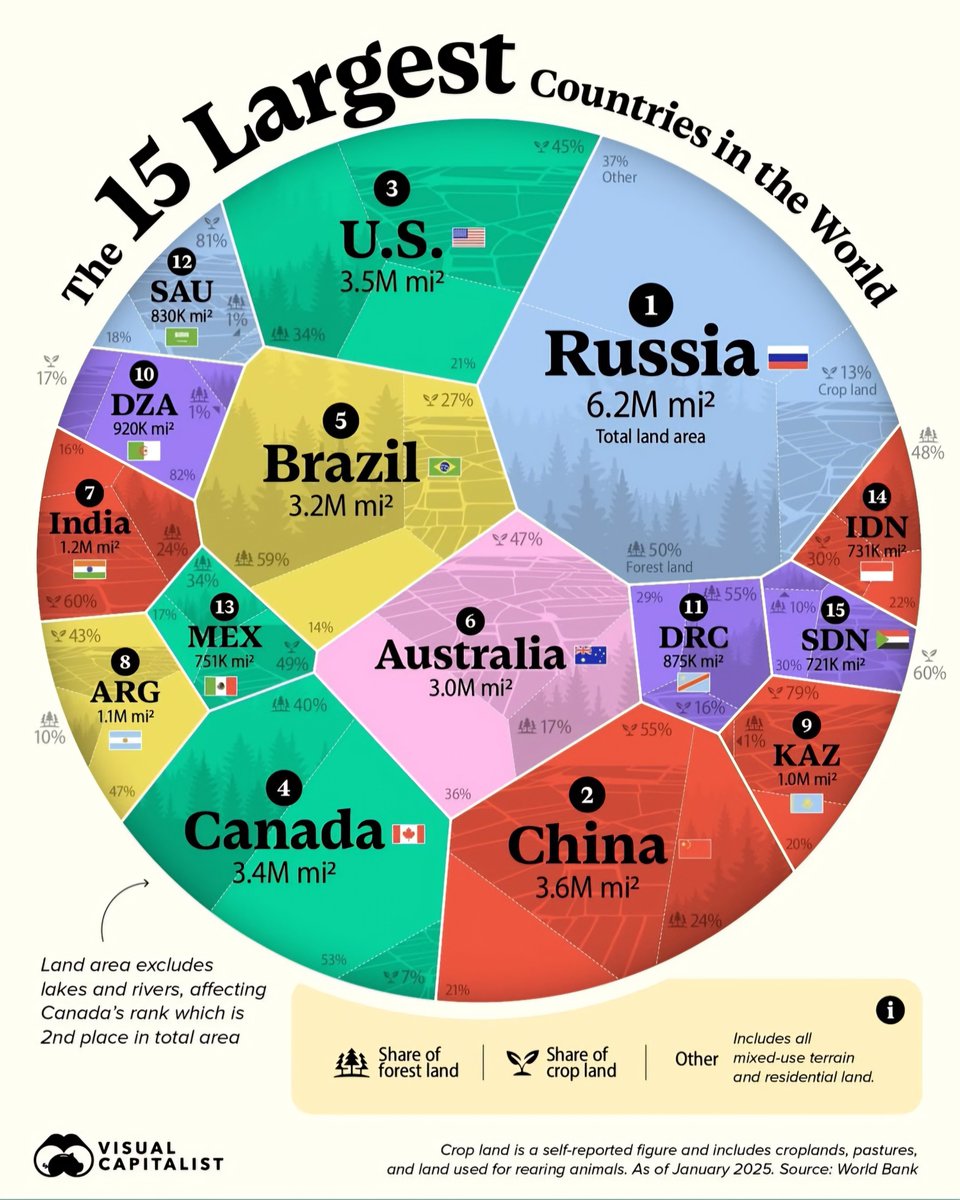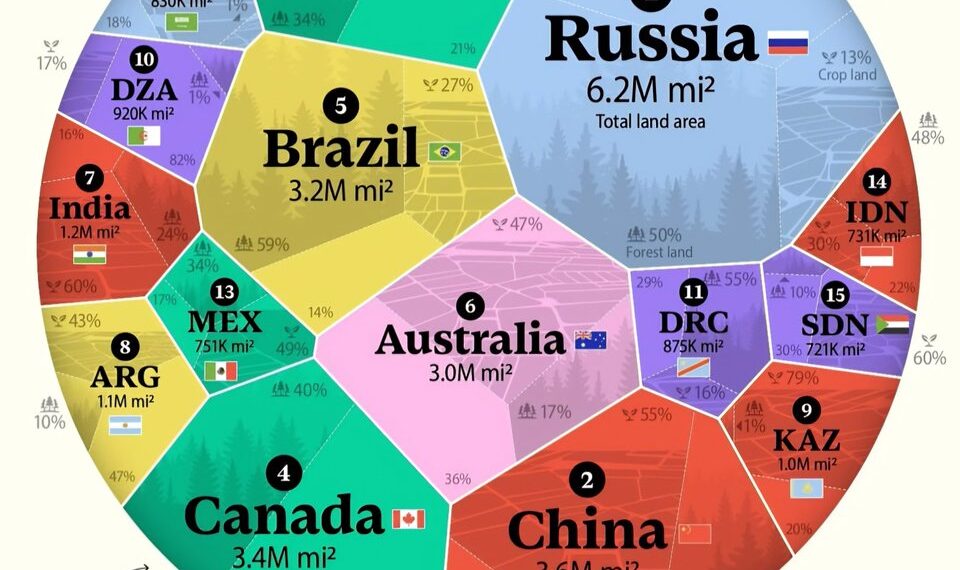Select Language:
Top 15 Largest Countries in the World by Land Area – 2025 Edition

1. Russia – The King of Landmass
Russia continues to hold its position as the largest country in the world, boasting an expansive land area of approximately 17.1 million square kilometers. Spanning across Eastern Europe and Northern Asia, Russia’s immense size encompasses a diverse range of climates, landscapes, and natural resources. Its vast territory is home to iconic landmarks like Lake Baikal and the Ural Mountains, showcasing an unparalleled natural beauty. The country’s strategic importance and resource wealth make it a dominant global player for 2025.
2. Canada – The Largest Country in the Western Hemisphere
Canada secures its place as the second-largest country, with around 9.98 million square kilometers of land. Known for its pristine wilderness, expansive forests, and thousands of lakes, Canada’s diverse environment includes the Arctic Archipelago, the Rocky Mountains, and lush coastal rainforests. Its vast land area supports a population of only 39 million, emphasizing the country’s remarkable balance of space and natural preservation.
3. United States – The Land of Opportunities
Covering approximately 9.83 million square kilometers, the United States ranks third globally. Its diverse terrain features everything from the Great Plains and the Appalachian Mountains to the deserts of the Southwest and the tropical climate of Hawaii. With a population nearing 340 million, the U.S. remains a cultural, economic, and technological powerhouse in 2025. The country’s immense size supports a variety of industries, from agriculture to aerospace.
4. China – The Middle Kingdom’s Vast Land
China’s land area extends to roughly 9.6 million square kilometers, making it the fourth largest country in the world. Its expansive territory includes the Himalayas, the Gobi Desert, and the lush Yangtze River basin. With over 1.4 billion people, China’s large landmass supports a complex socio-economic landscape, which continues to evolve amidst rapid development and modernization.
5. Brazil – Dominating South America
Brazil remains the largest country in South America with approximately 8.5 million square kilometers. Its territory encompasses the Amazon rainforest, the Pantanal wetlands, and vibrant coastal cities. Brazil’s vast size is key to its rich biodiversity and natural resources, positioning it as a crucial player in global environmental and economic discussions for 2025.
6. Australia – The Outback Continues to Surprise
Covering around 7.7 million square kilometers, Australia is the largest island continent in the world. Its distinctive landscape includes deserts, tropical forests, and mountain ranges. Population-wise, Australia is home to about 26 million residents, with most living along the coast. The country’s landmass is vital for its mining industries and unique ecological systems.
7. India – A Subcontinent of Superlatives
India’s land area is approximately 3.29 million square kilometers, making it the seventh largest country globally. Its immense geographic diversity includes the Himalayan peaks, fertile Gangetic plains, and arid Thar Desert. With a population exceeding 1.4 billion, India’s growing economy and cultural influence continue to expand in 2025.
8. Argentina – South America’s Second-Largest
Argentina covers about 2.78 million square kilometers and is renowned for its vast pampas, Andes mountains, and Patagonian wilderness. The country’s geography supports diverse agriculture and natural reserves, which are integral to Argentina’s economy and cultural identity.
9. Kazakhstan – The Land of Steppes
Kazakhstan, the largest landlocked country, spans roughly 2.72 million square kilometers. Its expansive steppes, deserts, and mountains make it a key player in Central Asian geopolitics. Rich in mineral deposits, Kazakhstan is a significant energy producer as of 2025.
10. Algeria – North Africa’s Largest
Covering about 2.38 million square kilometers, Algeria’s vast deserts and coastal plains shape its landscape. Its size makes it the largest country in Africa, vital for its oil and gas reserves which fuel its economy and regional influence.
11. Democratic Republic of the Congo – Central Africa’s Giant
This central African country encompasses around 2.34 million square kilometers. It is notable for its dense rainforests, extensive river systems, and vast mineral wealth. The DRC plays a vital role in regional stability and resource supply.
12. Greenland – The Largest Island
Though not a sovereign country, Greenland’s autonomous territory spans approximately 2.17 million square kilometers, making it the world’s largest island. Its vast ice sheets and Arctic environment are crucial to climate studies and geopolitics in 2025.
13. Saudi Arabia – The Desert Kingdom
At about 2.15 million square kilometers, Saudi Arabia dominates the Arabian Peninsula. Its landscapes include deserts, mountains, and coastal zones. The country remains a pivotal energy producer on the global stage.
14. Mexico – North America’s Southern Gateway
Mexico covers around 1.96 million square kilometers. Known for its vibrant cultural history and diverse ecosystems, Mexico’s size sustains a complex economy heavily reliant on manufacturing, agriculture, and tourism.
15. Indonesia – The Archipelagic Nation
With roughly 1.91 million square kilometers, Indonesia is the largest country in Southeast Asia. Its thousands of islands feature rainforests, volcanoes, and rich biodiversity, making it a key player in regional and global environmental issues in 2025.
As global dynamics shift, these countries’ sizes influence their strategic importance, resource management, and cultural diversity. Their vast territories serve as a testament to the natural and geopolitical complexity shaping the world in 2025.






